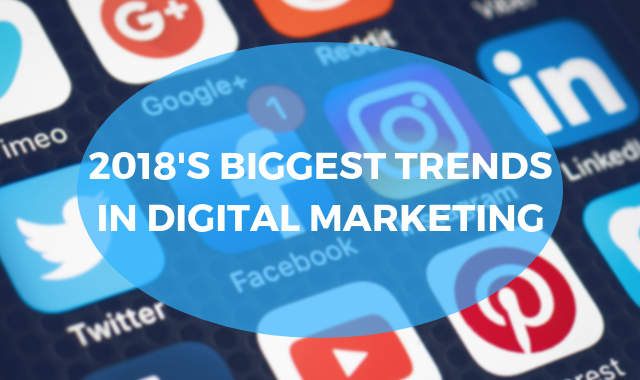Great marketing requires fluidity; you must be able to adapt to different trends, implement new tactics, and test out new powerful tools in order to stay ahead of the game. Consumers are constantly shifting and changing, so no matter what industry you work in or whether you’re a B2B or B2C company, you have to be continually looking towards the future.
Whether you’re crushing it with your current strategy or you need some new ideas to spice things up, you should consider these latest trends when implementing your marketing strategy.
General Marketing Trends
Marketing is a pretty broad term; there is brand marketing, content marketing, product marketing, search marketing, the list goes on and on… That’s why we decided to split the different trends into their respective categories.
Despite the many sectors of marketing, there are some trends that apply to every aspect of the marketing process. Whether you’re a social media marketer, a content marketer, or you work exclusively with SEO, these trends are something you should be paying attention to.
Customers as Marketers
Word-of-mouth is now, without a doubt, the single most valuable marketing tool in a merchant’s utility belt. That means the name of the game is no longer just acquiring customers – it’s creating a wonderful customer experience that influences them to be an advocate for your brand. Implement some strategies that ensure an enjoyable customer experience for all of your consumers.
- Focus on customer service – both online and in-person (if applicable)
- Engage with customers on social media and address any complaints as soon as they arise (be sure to avoid these common social media mistakes)
- Reward loyal customers with discount codes or free shipping to incentivize consumers to continue shopping with the company
Content Marketing Trends
As the year progresses, all kinds of businesses are rolling out new blogs or investing in content-related advertisements. Why? Because statistics don’t lie: 47% of buyers viewed 3-5 pieces of content before reaching out to a sales rep and 70% of people would rather learn about new products through content rather than ads.
Starting a blog is a great way to begin producing content, but in order to successfully engage with your audience, you must curate content that your audience interacts with and enjoys.
Two specific types of content have reigned superior this year (so far): personalized content and bite-sized content.
Personalized Content
As machine learning capabilities increase, customers are becoming more used to one-on-one experiences. Customers want to feel singled out; they enjoy when their buying experience is customized to fit their needs and wants. Statistics back up that theory: 78% of customers say that personalized content increases their purchase intentions and studies show that personalization can increase profits by 500%.
When personalizing content, follow these tips:
- Engage customers personally at every level. Include their first and last name in emails, curate your website experience to them personally using cookies, and try to respond to them in a personal manner on social media.
- Collect more data. More data equals more personalization. So ask for the first and last name before they download your guide or subscribe to your monthly newsletter. That way, you have at least the beginning of a leg to stand on when it comes to curating a customer experience.
Bite-sized Content
Did you know that Microsoft published a study showing that people’s average attention span is 8 seconds? You need to be keying in on customer’s critical issues, questions, and concerns with bite-sized content.
- GIFs, tweets, and short videos are all valuable content types that grab a user’s attention quickly.
- Try to convey the most important information during this short time. Also, even though the content length is short, you still need to brand. Get your brand in their brains in a repetitive, consistent way.
Social Media Marketing Trends
Social media has been rapidly changing this year. Instagram stories, IGTV, Facebook Stories, the list goes on and on. Social media marketing is crucial for eCommerce and can even increase sales, so make sure your platforms are up to date. Let’s take a look at where 2018 is heading when it comes to social media.
Permanent vs. Ephemeral Content
Instagram stories have really changed the game when it comes to content. There is now permanent content and temporary content to pay attention to. You need to be juggling both and coming out with fresh content both ways.
- Ephemeral content gives you a good chance to experiment and get a little raw. It’s temporary, so don’t funnel a bunch of funds into it. Keep it light-hearted and engaging.
- Remember: don’t lose focus on permanent content because you are experimenting with Snapchat or stories. Permanent content is just that: permanent. That content will be out there forever, so make sure it’s engaging and successfully branding your company.
Micro-influencers
Influencers have become a popular trend in modern day marketing. The process usually involves sending your products or services to an influencer, having them test out the products, and then featuring your company or products to their followers depending on the agreement.
Influencers as a whole have really risen this year, but micro-influencers, in particular, have been killing it.
A micro-influencer is a social media promoter with a smaller following – they aren’t technically celebrities, but many have die-hard fan bases that trust their judgment.
- Find people who would seem like a natural fit with your buyer’s persona. Don’t put your herbal products on the page of a competitive eater – it doesn’t make sense. The whole reason micro-influencers work is that their engagement levels are much higher than celebrities. People trust them. Make sure your products are naturally placed for the best ROI’s.
Search Marketing Trends
SEO marketers should be used to changing up their tactics on the fly. Google’s consistent shifting of algorithm patterns has forced many merchants to learn to adapt quickly. For 2018, one of the most significant SEO trends is the growth of Voice Search.
Voice Search
(We’ve already written an article on this topic, but in order to stress its importance, we’ll put the highlights in this article as well.)
When is the last time you used Siri? Or Alexa? Or Cortana? The list of voice-based assistants continues to grow and it is now predicted that by 2020, over 50% of searches will be voice searches. SEO marketers need to adapt to the way that voice queries search, and continue building a framework that adapts to voice while being consistent on Google search.
- A good first step is to start doing your research on voice trends. Voice search usually uses queries that are posed as a question. Keep that in mind.
GDPR’s Impact on Marketing
This year we all saw tons of privacy rules and regulations coming out of both North America and Europe. For us in the United States, GDPR required us to adapt to new policies regarding privacy.
General Data Protection Regulation
GDPR significantly changed the nature of how we deal with online privacy. We all use data to market, so make sure that you are compliant with GDPR (even if you don’t think you sell in Europe) because the fines are high and the negative publicity that comes with it can be even worse.
Those are a few of the many marketing trends we are tracking this year. If you are looking for more ways to market your eCommerce store or have questions regarding staying up to date with the latest regulations and marketing strategies, contact us today.















